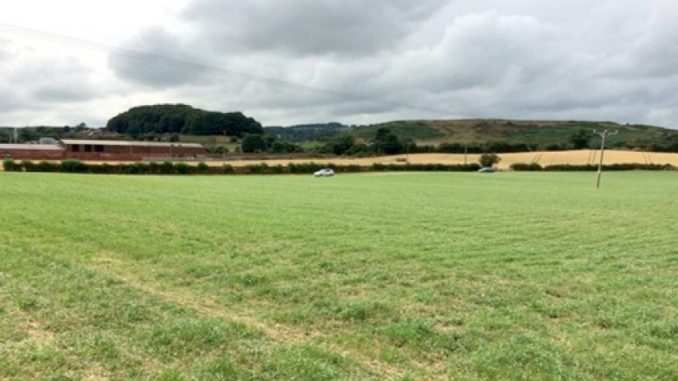
A campaign group has accused authorities of staggering double standards over development affecting Shropshire’s historic landscape.
The backlash comes as Shropshire Council’s conservation department and Historic England rally to object to development skirting Caer Caradoc hillfort near Church Stretton in the south of the County. Meanwhile, the two bodies have signed an outline agreement in Shropshire’s SAMDev local plan for 117 houses across the landscape of Old Oswestry hillfort in the north, despite fresh acknowledgement from leading academics of its national importance.
Shropshire Council conservation officer, Berwyn Murray, has argued that an application for 85 homes at Caer Caradoc will impact the hillfort and valley as well as a nearby grade II listed 18th century farmhouse. He cites concerns that the proposed development will “urbanise the currently open and agricultural wider setting.” John Yates, an inspector for Historic England, has also objected, saying that the hillfort would be “closer to the suburbs, and less rural” if the housing goes ahead.
Maggie Rowlands of campaign group, HOOOH (Hands Off Old Oswestry Hillfort), said: “We are encouraged that strong objections are being made in defence of these wonderful historic assets and rural landscape in Church Stretton. But the same arguments can and should be applied in the case of Old Oswestry given its widely- accepted national if not international significance.”
Nevertheless, Shropshire Council is refusing to acknowledge that Old Oswestry’s historic farmland setting faces similar degradation from development sweeping ever closer to the monument. It has stated it “does not accept that proposed development (OSW004) would result in substantial harm to the significance of the hillfort.” And it claims that “the sensitivity of the Old Oswestry hillfort and its setting have been recognised by Shropshire Council throughout the local plan-making process.”
HOOOH points out that the Council’s opinion has not been supported by any evidence and is in stark contrast to the assessment by a group of 12 eminent British archaeologists that housing would cause “irreparable harm to the hillfort’s setting”. They include Professor Sir Barry Cunliffe and Professor Lord Renfrew of Kaimsthorn, while RESCUE (British Archaeological Trust), the Council for British Archaeology and The Prehistoric Society have all made similar objections. Testifying to the hillfort’s significance, representatives among them have described it as the “Stonehenge of the Iron Age” and in the “Premier League of British archaeological sites”.
“We ask why so little support to protect this significant hinterland landscape has come from Shropshire’s historic environment team,” said Mrs Rowlands. “It appears that OSW004 is being forced on us by the political will of the Council to fulfil their housing quota in SAMDev at any cost.”
Tim Malim, heritage planning adviser to HOOOH, said: “There is an inexplicable lack of appreciation for one of Shropshire’s and the UK’s most important heritage assets. There is also a serious lack of understanding for planning policy and the heritage significance of the hillfort’s setting in believing that development at OSW004 is sound. The LPA is leaving itself wide open to legal challenges while there is such glaring inconsistency in the interpretation of planning guidance in relation to the County’s heritage.”
Campaigners are also extremely disappointed with Historic England’s capitulation over OSW004. Having objected during the early stages of SAMDev, the national body has since agreed principles for housing, subject to design approval, in a statement of common ground. This is despite its stated concerns over the loss of the hillfort’s rural setting to urban development and the disruption of views to and from the hillfort that contribute to the aesthetic value.
HOOOH says that Historic England’s contradictory approach is further highlighted by its objection to the allocation of land in SAMDev to extend an industrial park adjacent to Shrewsbury’s historic Battlefield. The heritage body is concerned about the impact of development on key views to and from the site, and potential harm to the registered battlefield’s wider designation. This is a directly parallel situation with OSW004 at Old Oswestry, say campaigners.
Mr Malim added: “We have submitted evidence to the LPA showing that there would be substantial impacts on the heritage significance of Old Oswestry from the urban encroachment of 117 houses. These include assessments using industry standard methods and Historic England’s own criteria on the setting of heritage assets.”
Rulings
However, HOOOH says it is encouraged that rulings elsewhere are providing some clarity on the interpretation of harm to heritage setting under national planning guidelines (NPPF).
In 2013, the Court of Appeal overturned plans for four wind turbines on land at the 17th century Barnwell Manor near Lyveden New Bield in Northamptonshire. The judge ruled there had been a failure by a public inquiry inspector “properly to interpret and apply the relevant planning policies on the effect of development on the setting of heritage sites, which meant that the balancing exercise was flawed”.
The ruling has had notable repercussions for planning applications affecting heritage sites.
Andrew Batterton, legal director for global law firm, DLA Piper LLP, wrote in The Planner magazine earlier this year: “Even less than substantial harm impacts that fail to preserve setting and that contribute to significance of a heritage asset are now expected to be afforded considerable weight, creating a strong presumption against the grant of planning permission.”
HOOOH says if proper weight is given to Old Oswestry’s significance, the scale of harm from development in its setting, and to its community value as a heritage asset, then any unbiased balancing exercise regarding harm versus the need for housing must clearly rule OSW004 as unsound.
The SAMDev plan has been undergoing examination by Inspector Claire Sherratt for more than a year. She is expected to submit her final plan to Shropshire Council in the next few weeks.
Leave a Reply